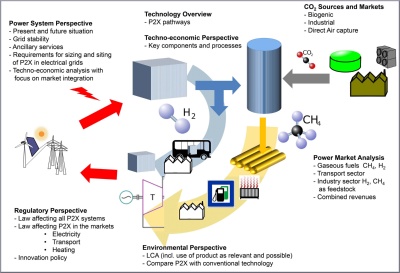White Paper on the Perspectives of P2X Technology in Switzerland
Power-to-Product (P2X) refers to technologies that use (surplus) electricity, ideally from fluctuating renewable energy sources, to synthesize (gaseous) chemical products, like hydrogen or hydrocarbons. In the first step of this process, electricity is used to split water to oxygen and hydrogen via electrolysis. Produced hydrogen can then be used directly to power fuel cell electric vehicles or fed into the natural gas grid (up to 10% by volume). Furthermore, this renewable hydrogen can also be provided to the chemical industry, as it is a key feedstock material for many applications.
P2X System (image as a pdf-document)
In a second step, hydrogen from electrolysis can be combined with carbon dioxide (CO2) via a methanation reaction to produce synthetic natural gas (SNG) or other synthetic hydrocarbons (i.e. methanol). If atmospheric CO2 is used, then it can act as an effective carbon sink. SNG can be supplied to the gas grid for heating/cooling purposes, used to generate electricity during high-demand periods or as a fuel for gas engine vehicles.
While the rising share of renewable electricity (e.g. from wind and solar technologies) has positive implications for lowering CO2 emissions and promoting the energy transition, managing the electricity grid will become increasingly challenging. This is because electricity production from renewable sources is not constant and therefore it does not always match the demand in time and space. These discrepancies are mainly due to day/night cycles, weather, seasonal shifts as well as geographical conditions. This requires multi-dimensional grid balancing and P2X technologies may offer potential solutions and provide the necessary grid flexibility.
The SCCER Joint Activity White Paper on the Perspectives of Power-to-Product (P2X) Technology in Switzerland is a collaborative effort between SCCER Mobility, SCCER HaE, SCCER CREST, SCCER BIOSWEET and SCCER FURIES. It will gather state of the art knowledge on P2X technologies and assess the economic, environmental, regulatory challenges as well as its potential for the Swiss energy market. The outcomes of this study will be synthesized in a white paper, which will serve as a guide for policy makers to reach the emission and power supply goals of the Swiss Energy Strategy 2050. The white paper will analyze the following aspects:
- Electrolyzer technology to produce hydrogen
- Methanation technologies with different product inputs (e.g. bioenergy, CO2 from industry) with and without carbon capture and storage (CCS)
- Storage technologies for hydrogen and SNG
- Technologies for injecting hydrogen or SNG into the natural gas grid
- Selected hydrogen technologies in the energy end-use sectors (transport and industry)
- Technologies to produce synthetic liquid fuels, mainly to be used as a fuel in the transport sector or as a feedstock in industry (methanol and ethanol)
- Stationary technologies for re-electrification of hydrogen (fuel cell technologies)
- Temporal and spatial resolved electricity flow analysis
- Analysis of the CO2 reduction potential for several end-users (e.g. mobility, re-electrification, industrial products)
- Feasibility of implementation of P2X technology as a mid-term and/or long-term energy storage option
- Applicability of P2X technology in place of the grid upgrade/expansion, both in transmission and distribution levels, especially in light of emergence of renewable power intermittency and over-generation.
- Feasibility of P2X technology as an ancillary service provider
- Compilation of case studies of P2X technology in Switzerland with an aim to assess its multi-aspect feasibility in the future
The White Paper
Available for download in English, auf Deutsch, en français, full report (in English)
Dr. Tom Kober
Paul Scherrer Institute
Coordinator of the joint SCCER activity White Paper P2X
tom.kober@psi.ch
Dr. Jörg Roth
Coordinator SCCER Heat and Electricity Storage HaE
info@sccer-hae.ch
!!! This document is stored in the ETH Web archive and is no longer maintained !!!
